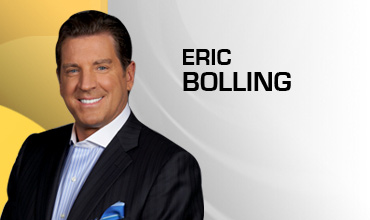Eric Bolling
- Personalities
- Alexis Glick
- Neil Cavuto
- David Asman
- Cheryl Casone
- Dagen McDowell
- Liz Claman
- Adam Shapiro
- Ashley Webster
- Charles Payne
- Brian Sullivan
- Cody Willard
- Connell McShane
- Dave Ramsey
- Elizabeth MacDonald
- Eric Bolling
- Jeff Flock
- Jenna Lee
- Nicole Petallides
- Peter Barnes
- Rebecca Diamond
- Rich Edson
- Robert Gray
- Sandra Smith
- Shibani Joshi
- Stuart Varney
- Tom Sullivan
- Tracy Byrnes
- On Air
Eric Bolling

Eric Bolling is a co-host of FOX Business Happy Hour and the host of the 3 p.m. hour of FOXNews.com’s Strategy Room Web show.
Bolling joined the FOX Business Network (FBN) as a contributor in March 2008.

He has recently served as an independent trader based out of the New York Mercantile Exchange (NYMEX), the world’s largest trading center for energy. He specialized in trading a variety of commodities such as crude oil, gold and agricultural commodities. He served on the NYMEX’s Board of Directors for five years, and subsequently acted as a strategic advisor there.
Bolling actively trades equities, options and derivatives and is a member of the Intercontinental Exchange (ICE), the NYMEX and the Commodities Exchange of New York.
Prior to this, Bolling served as a CNBC contributor for two years, where he spent a year and a half as a panelist on Fast Money. He also was the recipient of the Maybach Man of the Year award at the Trader Monthly Awards in January 2007.
Bolling also spent time as a professional baseball player for the Pittsburgh Pirates.
A graduate of Rollins College in Winter Park, Florida, Bolling was awarded a fellowship to Duke University’s School of Public Policy.
Eric's on Twitter. Follow him here: http://twitter.com/ericbolling

FOX Translator
No data currently available.
No data currently available.
Ever been to a clearance sale at a department store and wonder how a massive store like Macy's or Saks can have 50%, 60%,
or even 75%-off sales and still remain in business? Ever wonder why that piece of cloth that an Italian designer calls a dress
can be worth $2,400, and how much it really costs to make and sell?
Ladies and gentlemen, let's talk profit margin.
Profit margin is the difference between how much it costs a company to manufacture, transport and sell its products, and how
much it sells them for. If a company made $10 million in profit of sales of $100 million, the profit margin is 10%. You get
that number by dividing the profit ($10 million) by the income ($100 million). Usually you'll hear profit margin as a percentage.
The
profit margin is a great way to tell how well a company is run. If you have a high profit margin in a company, that means
that the company's costs to make the product are low and it can withstand changes in price fairly well. Also you can use profit
margin to tell how well a company is run when you look at similar companies.
Let's say you were looking a two candy companies. One has a profit margin of 15%, off $200 million in sales. The other company has a profit margin of 7% off $400 million in sales. The $400 million candy company's profit margin shows the company is having trouble keeping costs down. It might be spending too much money on their CEO's private jet, or their sugar suppliers aren't as good as they could be. Anyway, if investors were looking at the $400 million candy company, they would be asking some serious questions.






